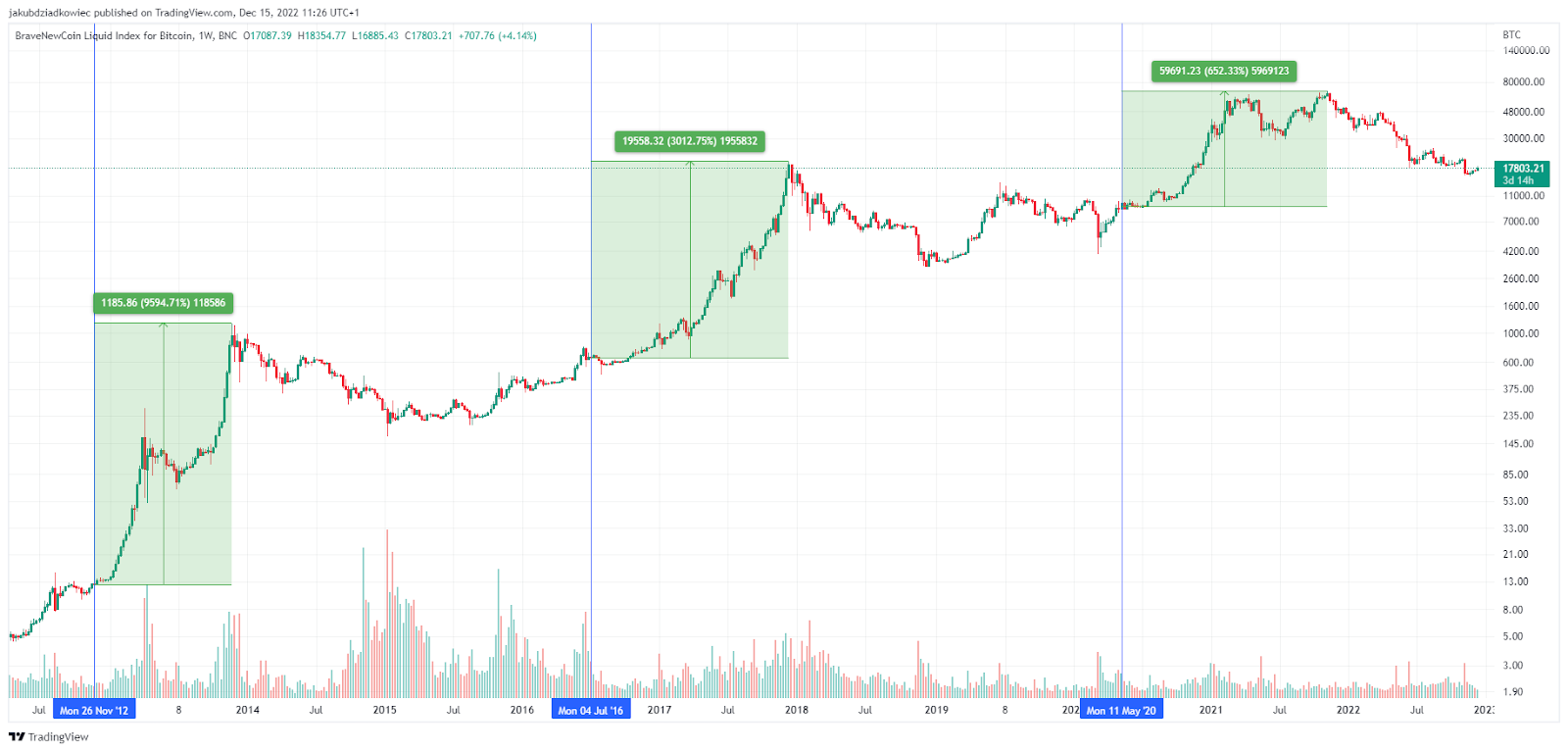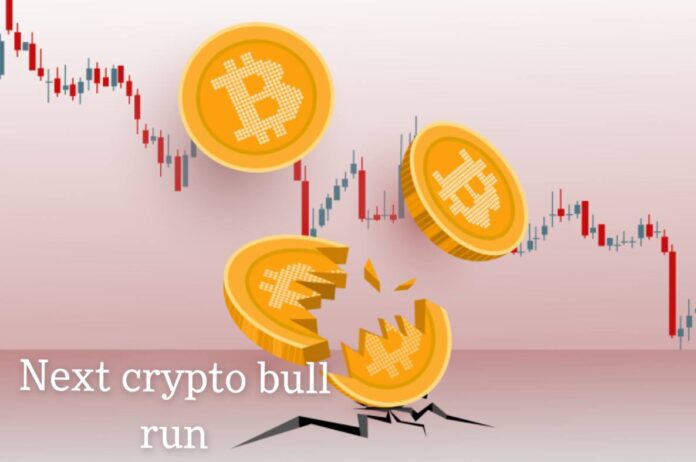Table of contents
As everyone anticipates the next crypto bull run, hopes are high that there will be a break from the bear days and likely some bulls. Many investors and the crypto community are searching for clues and market trends to take advantage of the next crypto bull run. No one wants to miss out on the next crypto opportunity. In this article, we’ll examine the idea of a crypto bull run, the influence of Bitcoin halving on the crypto market, and discuss when the next crypto bull might occur.
A brief history of the Bitcoin bull run
According to a data analysis by Coincodex, Bitcoin has experienced three significant bull markets. The first important Bitcoin bull run began in 2013 when the price of Bitcoin crossed the $1,000 threshold for the first time. The cost of Bitcoin decreased in January 2015 after reaching a top of $1,150 in December 2013. In 2015 Bitcoin reached a bottom of $171, an 85% decrease from its initial price.
Meanwhile, in the second quarter of 2016, the Bitcoin price began to skyrocket, and in December, it accumulated to an all-time high price of under $20,000. Here we can notice similarities between the Bull Run in 2013 peaks and the 2017 bull run, four years apart.
When 2017 began to lose its grip, it took a year to find a bottom of 3200$ from its initial peak of 19,900$, an 84% decline from its initial price.
From Data Analysis, the bull run in 2013 and 2017 had the same similarities. Each took a year to find its bottom and subsequently had a percentage decline of 85% and 84%.
In 2021 the third major Bitcoin rally kicked off. This rally peaked at the price of 68,770 in November 2021, which is the all-time high of Bitcoin today.
| Peak (date) | Bottom after peak (date) | Drawdown between peak and bottom | |
| 2013 BTC bull run | $1,150 (December 2013) | $171 (January 2015) | -85% |
| 2017 BTC bull run | $19,900 (December 2017) | $3,200 (December 2018 | -84% |
| 2021 BTC bull run | $68,700 (November 2021) | $15,600 (November 2022) | -77% |
So far from 2022, its peak declined to the lowest price of $15,600 in November 2022 after the significant Bull in November 2021. Like the other bulls, it took one year to reach its bottom, but this time, it has a percentage decrease of 77% ($68,770 to $15,600), a slightly less crash than the other two bull runs.
When is the next Bull run?
Several factors could influence the next bull run, which we will examine in the next paragraph. From all expectations, if history could repeat itself and follow the previous patterns, we could see the next Bull starting in the second quarter of 2024 and could reach its peak in the first quarter of 2025.
These are all speculations; Bitcoin has only been around for a decade, and its market is still unpredictable as we might see new events unfold.

What could fuel the next Bitcoin bull run?
Bitcoin halving
Bitcoin halving is an essential event that happens approximately every four years in the Bitcoin network. Let’s imagine a virtual gold mine where new Bitcoins are produced to understand it.
In this mine, miners work hard to solve complex mathematical puzzles. When they solve a mystery, they are rewarded with newly created Bitcoins. However, to maintain the scarcity of Bitcoin, the number of new Bitcoins released into the system needs to be limited.
During a halving event, miners’ number of new Bitcoins as a reward for solving puzzles is reduced by half. It’s like reducing the amount of gold nuggets miners find in the virtual mine. Initially, the prize was 50 Bitcoins per solved puzzle. Then, in the first halving, it decreased to 25 Bitcoins, and later to 12.5 Bitcoins in the second halving.
This reduction in Bitcoin rewards serves two essential purposes. First, it controls the rate at which new Bitcoins enter circulation, preventing inflation and ensuring scarcity. Second, it creates a predictable supply schedule, gradually decreasing the rate of new Bitcoin creation over time.
As the supply of new Bitcoins decreases due to halving, it can affect the balance of supply and demand.
If Bitcoin’s demand increases in the future or remains strong while the supply decreases, it can create upward pressure on the price. Historically, This has led to significant price increases, as the halving event increases scarcity and the perceived value of existing Bitcoins.
Ultimately, Bitcoin halving is a vital mechanism designed to manage the supply and ensure a controlled release of new Bitcoins into the market. It is a fundamental aspect of Bitcoin’s monetary policy and contributes to its unique properties as a decentralized digital currency.
Other factors that trigger a crypto bull run.
We have discussed Bitcoin halving and how it has significantly triggered bull runs, but we must remember to look at several other factors that also started bull runs in the past years.
Other significant crypto assets and products can also trigger bull runs. Let’s consider Ethereum, which is the second most potent crypto coin. In contrast, Bitcoin provides a peer-to-peer digital currency that eases the means of money transfer from one place to another within secs eliminating the stress of the traditional banking system, in which you will have to wait for days and a lot of paperwork to be able to transfer money. Ethereum, on the other hand, took a step further to provide powerful smart chain functionality that allows anyone to launch new decentralized applications.
These smart chains resulted in other new products, including NFTs, other decentralized crypto exchanges, trading, marketplaces, lending protocols, etc.
Though Ethereum has yet to reach its mainstream adoption and still needs scalability(ability to run several users and fewer gas fees), there are initiatives on both layers to provide this scalability to many users and provide faster transactions. It could be a foundation for the next bull run if they can achieve these efficiently.
Final thoughts.
We are considering the brief history of Bitcoins over the years, showing a regular pattern from 2013 till date. History might be repeating itself as we are seeing signs and might have the next Bull run in the second quarter of 2024 and maybe have its peak in the first quarter of 2025. On the other hand, Bitcoin has a tiny sample size. It has only been around for a decade, making it difficult to predict it or have a conclusion accurately. If you are investing or just trying to throw a few bucks into it. Always do your own research before investing in Bitcoin. In subsequent articles, we will cover topics on how to invest appropriately in cryptocurrency. Thanks !!





